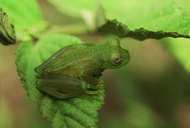|
Description
Cochranella nola adult males range from 20.7-21.1mm while females are slightly larger at 24.4-25.7mm (Harvey 1996; Kohler 2000). This species has (1) vomerine teeth present; (2) truncate snout; (3) large widely spaced eyes; diameter twice width of finger disc III; (4) tympanum small, indistinct; tympanic annulus also indistinct, covered by low supratympanic fold; (5) dorsal and lateral surfaces finely granulated, hands and feet smooth; (6) parietal peritoneum white, visceral peritonea clear; (7) tri-lobed liver; (8) humeral spine absent; (9) absence of melanophores on fingers; (10) extensive webbing between fingers III, IV; basal webbing between all other fingers; (11) long, slender hind legs; (12) extensive webbing between toes; (13) subcloacal folds and paired tubercle ornamentation absent; (14) bones dark green (Harvey 1996).
Coloration in life: dorsal and lateral surfaces monochromatically green and covered with fine spiculates; clear, green tongue; white upper lip; iris light grey with black reticulations; white optical sclera which can be seen from ventral view of head; eyelid white; white parietal peritoneum and clear visceral peritonea, yellow intestines (Harvey 1996). Distribution and Habitat
Country distribution from AmphibiaWeb's database: Bolivia, Peru
This species is endemic to Bolivia, within the Departamento Santa Cruz. It is found along streams in dry, semi-deciduous montane forests, humid montane forests, and rainforests, at altitudes of 500m to 1750m asl (De la Riva et al. 2000; Harvey 1996; Kohler 2000; Lotters and Kohler 2000), such as the Quebrada El Fuerte, a fast-flowing tributary of the Río Piray (Harvey 1996). Life History, Abundance, Activity, and Special Behaviors
Calling males have been found perched on vegetation 0.3-5 m above the fast-flowing, 1m deep, gravel-bottomed, sun-exposed stream, or on boulders in the stream. Males called as individuals or as small groups of no more than six, and were spaced out 2-20cm from each other. Mating calls consisted of a single high pitched note, sounding like a sharp "pink," or a series of three rapid notes. The calls occurred at irregular intervals (Harvey 1996; Kohler 2000). Egg clutches are amassed on stream rocks (IUCN 2008). Trends and Threats
The species is categorized as Near Threatened because its habitat is probably declining in quality as well as quantity, and the population of this species is declining. However, it is not qualified as Vulnerable because the species is almost certainly assumed to occur in a wider range of area than the Departamento Santa Cruz. The major threat is agricultural contamination of water (IUCN 2008). Possible reasons for amphibian decline Intensified agriculture or grazing
Local pesticides, fertilizers, and pollutants
Comments
The etymology is from the Latin noun nola which means "a little bell", referring to Cochranella nola's high-pitched call (Harvey 1996).
References
De la Riva, I., Köhler, J., Lötters, S. and Reichle, S. (2000). ''Ten years of research on Bolivian amphibians: updated checklist, distribution, taxonomic problems, literature and iconography.'' Revista Espanola de Herpetologia, 14, 19-164.
Harvey, M. B. (1996). ''A new species of glass frog (Anura: Centrolenidae: Cochranella) from Bolivia, and the taxonomic status of Cochranella flavidigitata.'' Herpetologica, 52(3), 427-435.
IUCN, Conservation International, and NatureServe. (2008). Global Amphibian Assessment: Cochranella nola. www.globalamphibians.org. Accessed on 22 October 2008.
Kohler, J. (2000). ''Amphibian diversity in Bolivia: A study with special reference to montane forest regions.'' Bonner Zoologische Monographien, 48, 1-243.
Lötters, S., and Köhler, J. (2000). ''Cochranella nola (Anura: Centrolenidae): natural history notes, distribution, and advertisement call.'' Herpetological Natural History, 7(1), 79-81.
Originally submitted by: Xi Zhai (first posted 2008-10-22)
Edited by: Kellie Whittaker (2012-05-16)Species Account Citation: AmphibiaWeb 2012 Cochranella nola <https://amphibiaweb.org/species/5561> University of California, Berkeley, CA, USA. Accessed Jan 5, 2025.
Feedback or comments about this page.
Citation: AmphibiaWeb. 2025. <https://amphibiaweb.org> University of California, Berkeley, CA, USA. Accessed 5 Jan 2025.
AmphibiaWeb's policy on data use.
|
